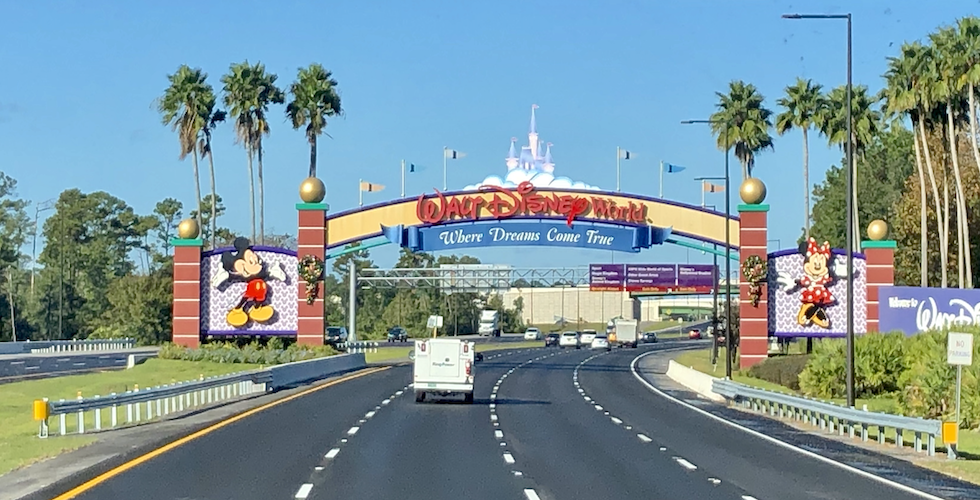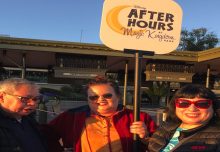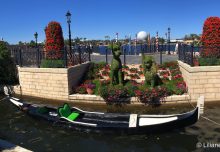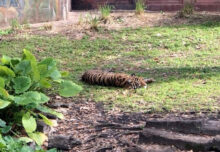Today Bob Sehlinger, coauthor of The Unofficial Guide to Walt Disney World, presents us with a little history of Florida tourism before and after Disney. Get ready to discover all about the attraction that ate Florida.

Before Walt Disney World, Florida was a happy peninsula of many more-or-less-equal tourist attractions. Distributed around the state in great proliferation, they constituted the most perennially appealing vacation opportunity in the United States. There was the Monkey Jungle, the Orchid Jungle, venerable Marineland, the St. Augustine Alligator Farm, Silver Springs, the Miami Wax Museum, the Sunken Gardens, the Coral Castle, and the Conch Train Tour. These, along with Cypress Gardens, Busch Gardens, and others, were the attractions that ruled Florida.
Now those remaining survive precariously in the shadow of the greatest attraction of them all, Walt Disney World. With doors still open, many of the old standbys continue to welcome tourists, thank you, but when was the last time you planned your vacation around the Conch Train tour?
When Walt Disney World arrived on the scene, Florida tourism changed forever. Before Disney (B.D.), southern Florida was the state’s and the nation’s foremost tourist destination. Legions of tourists sunned on the beaches of Miami, Hollywood, and Fort Lauderdale and patronized such nearby attractions as the Miami Serpentarium, Seaquarium, and the Parrot Jungle. Attractions in the Ocala and St. Augustine area upstate hosted road travelers in great waves as they journeyed to and from their southern Florida destinations. At the time, Orlando was a sleepy little central Florida town about an hour’s drive from Cypress Gardens, with practically no tourist appeal whatsoever.
Then came Disney, and it was not as if Walt had sneaked up on anyone, though he had a bunch of entities individually buying up land before anyone knew they were fronting Disney. To the contrary, once the Mouse was out of the bag he came openly and bargaining hard, asking for improved highways, tax concessions, bargain financing, and community support. So successful had been his California Disneyland that whatever he requested, he received.
Generally approving, and hoping for a larger aggregate market, the Florida attractions industry failed to discern the cloud on the horizon. Walt had tipped his hand early, however, and all the cards were on the table. When Disney bought 27,500 central Florida acres, it was fairly evident that he did not intend to raise cattle. As an aside, the Church of Jesus Christ of Latter-day Saints (Mormon Church) bought 300,000 acres 50 miles south of Orlando expressly for the purpose of raising cattle. They now have upwards of 44,000 head, making the Florida spread the largest cattle ranch in the United States.
The Magic Kingdom opened on October 1, 1971, and was immediately successful. Hotel construction boomed in Orlando and Kissimmee and around Walt Disney World. Major new attractions popped up along recently completed Interstate 4 to cash in on the wellspring of tourists arriving to tour Disney’s latest wonder. Walt Disney World was on its way to becoming a destination, and suddenly nobody cared as much about going to the beach. The Magic Kingdom was good for two days, and then you could enjoy the rest of the week at Sea World, Cypress Gardens, Circus World, Gatorland, Busch Gardens, the Stars Hall of Fame Wax Museum, and the Kennedy Space Center.

These various satellite attractions, all practically new and stretching from east coast to west coast, formed what would come to be called the Orlando Wall. No longer did tourists pour into Miami and Fort Lauderdale. Rather, they held up at the Orlando Wall and exhausted themselves and their tourist dollars at the shiny modern attractions arrayed between Cape Canaveral and Tampa. In southern Florida, venerable old attractions held on by a parrot feather—and more than a few closed their doors. Flagship hotels on the fabled Gold Coast went bust or were converted to condominiums for throngs of retirees.
When Walt Disney World opened, the very definition of a Florida tourist attraction changed. Setting standards for cleanliness, size, scope, grandeur, variety, and attention to detail, Walt Disney World overnight relegated the majority of Florida’s other attractions to positions of comparative insignificance. Newer attractions, such as Sea World and the vastly enlarged Busch Gardens, strove successfully to achieve the new standard. Cypress Gardens, Weeki Wachi, and Silver Springs expanded and modernized. Most other attractions, however, slipped into a limbo of diminished status from which they never recovered. Far from being headliners or tourist destinations, they plugged along as local diversions, pulling in the curious, the bored, and the sunburned for two-hour excursions.

Many of the affected attractions were wonderful places to spend a vacation day, but even collectively, as has been sadly demonstrated, they do not command sufficient appeal to lure many tourists beyond the Wall. We recommend those that survived, however, not only for their variety of high-quality offerings, but as a glimpse of Florida’s golden age, a time of less sophisticated, less plastic pleasures, before the Mouse. Take a day or two and drive three-and-a-half hours south of Orlando. Visit the Miami Seaquarium, try Vizcaya, Fairchild Tropical Gardens, and Lion Country Safari. Drive Collins Avenue along the Gold Coast. You’ll be glad you did.
When EPCOT Center (as it was originally called) opened in Walt Disney World in October, 1982, another seismic shock reverberated through the Florida attractions industry. This time it was not only the smaller and more vulnerable attractions that were affected, but also the newer large-scale attractions along the Orlando Wall. Suddenly, with EPCOT Center, Walt Disney World had swallowed up another one to two days of each tourist’s vacation week. When the Magic Kingdom stood alone, most visitors had three or four days remaining to sample other attractions. With the addition of EPCOT Center, that available time was cut to one or two days.

Disney ensured its market share by creating the multiday “park hopping” admission passes, which allowed unlimited access to both the Magic Kingdom and EPCOT Center. More cost-efficient than a one-day pass to a single park, these passes had the effect of keeping the guest on Disney turf for three to five days.
Incidentally, EPCOT was one of Walt’s enduring passions. The EPCOT acronym stood for Environmental Prototype City of Tomorrow. In Walt’s vision it would be a living, breathing futuristic city—a community based on the most forward-thinking technology and ideas. When Walt died, EPCOT pretty much died with him. Corporate Disney chunked the city of tomorrow dream and built a theme park.
The Kennedy Space Center and Sea World, by virtue of their very specialized offerings, continued to prosper following the opening of EPCOT Center. Most other attractions, however, were forced to focus more of their energy on local markets. Some, like Busch Gardens, did very well, with increased local support replacing the decreased numbers of Disney World destination tourists coming over for the day. Others, like Cypress Gardens, suffered badly but worked diligently to improve their product. Some, like Circus World and the Hall of Fame Wax Museum, passed into history.

Though long an innovator, Disney turned in the mid-1980s to copying existing successful competitors, except that copying is not exactly the right word. What Disney did was to take a competitor’s product concept, improve it, and reproduce it in Disney style on a grand scale.
The first competitor to feel the heat was Sea World when Disney added The Living Seas pavilion to the Future World section of EPCOT Center. Sea World, however, had killer whales, the Shark Encounter, and sufficient corporate resources to remain preeminent among marine exhibits. Still, many Walt Disney World patrons willingly substituted a visit to The Living Seas for a visit to Sea World.
Disney had one of its own products threatened when the Wet ’n Wild Water theme park took a shot at the older, smaller, but more aesthetically pleasing River Country adjoining Disney’s Fort Wilderness Campground. Never one to take a challenge sitting down, Disney responded in 1989 with the opening of Typhoon Lagoon, the largest swimming theme park in the world at the time.

Also, in 1989 Disney opened Pleasure Island, a one-admission multi-nightclub entertainment complex patterned on downtown Orlando’s successful Church Street Station. In the first years Pleasure Island was operating, it robbed Church Street Station of much of its destination tourist traffic.

Finally, and most significantly of all, in 1989 Walt Disney World opened the Disney-MGM Studios, a combination working motion picture and television production complex and theme park. Copying the long-heralded Universal Studios tour in southern California, the Disney-MGM Studios were speeded into construction and operation after Universal announced its plans for a central Florida park.
This newest of the Walt Disney World theme parks, however, affected much more than Universal’s plans. With the opening of Disney-MGM, the 3-Day World Passport was discontinued. Instead, Disney patrons were offered either a single-day pass or the more economical multiday passports, good for either four or five days. With the three theme parks on a multiday pass, plus two swimming parks (Typhoon Lagoon and River Country), several golf courses, various lakes, and a nighttime entertainment complex, Disney effectively swallowed up the average family’s entire vacation. Break away to Sea World or the Kennedy Space Center for the day? How about a day at the beach (remember the ocean)? Fat chance.
With the opening of the Walt Disney World Swan and Dolphin hotels, and the Conference Center, Disney took a quantum leap toward monopolizing the business and convention traveler as well. With over 250,000 square feet of exhibit space, the Conference Center was one of the largest in the Southeast.

In 1995 Disney opened Blizzard Beach and began plans for a fourth major theme park, a zoological park designed to compete directly with Busch Gardens.

During the same year, the first phase of Disney’s All-Star Resorts came on line, featuring (by Disney standards) budget accommodations. The location and rates of the All-Star Resorts were intended to capture the market of the smaller independent and chain hotels situated along US 192.

Disney even discussed constructing a monorail to the airport so that visitors would not have to set a single foot in Orlando. [They ultimately achieved their goal in 2005 with the opening of Disney’s Magical Express, free bus transportation from and to the airport for Disney resort guests.]

I regret the passing of an era in Florida tourism. The old attractions were more intimate, more personal, more human. The live alligators were more interesting (if less predictable) than the Disney robotic version, and I found I could stomach the pungent odor of a real Florida panther. Each modest attraction embodied the realization of some maverick’s dream, a dream he longed to share with anyone who passed through the turnstile. But dreams are only as grand as the people who create them, and only the truly visionary endure. Such was the dream of Walt Disney, come to fruition in Walt Disney World.
From an entrepreneurial seed, a cartoon mouse, and a California amusement park years ahead of its time rose a corporate entertainment giant, a giant that sometimes moves clumsily and sometimes with cold, hard determination but always with a commitment to quality (though that commitment has been questioned in recent years).
I am not sure that I like the idea of the Walt Disney Company monopolizing and orchestrating a Florida visitor’s entire vacation, but the Universal parks and LEGOland are serving Disney a taste of its own medicine and then some.

While Disney has remained cautious and plodding, Universal has unleashed one ground-breaking attraction after another.

The Imagineers really upped their game with the opening of Pandora—Avatar Land at the Animal Kingdom and have opened their most ambitious theme area ever in Star Wars Galaxy’s Edge at the Disney Hollywood Studios. Universal, however, continues to demonstrate that it can think big, act quickly, and be willing to invest.


If you enjoyed Bob’s take on the attraction that ate Florida, please subscribe to our YouTube channel and sign up for our newsletter here. Be sure to follow us on Twitter, Facebook, Instagram, and YouTube.
Picture of Cypress Gardens courtesy of Alan C. Teeple User: ACT1, CC BY-SA 3.0, via Wikimedia Commons.





